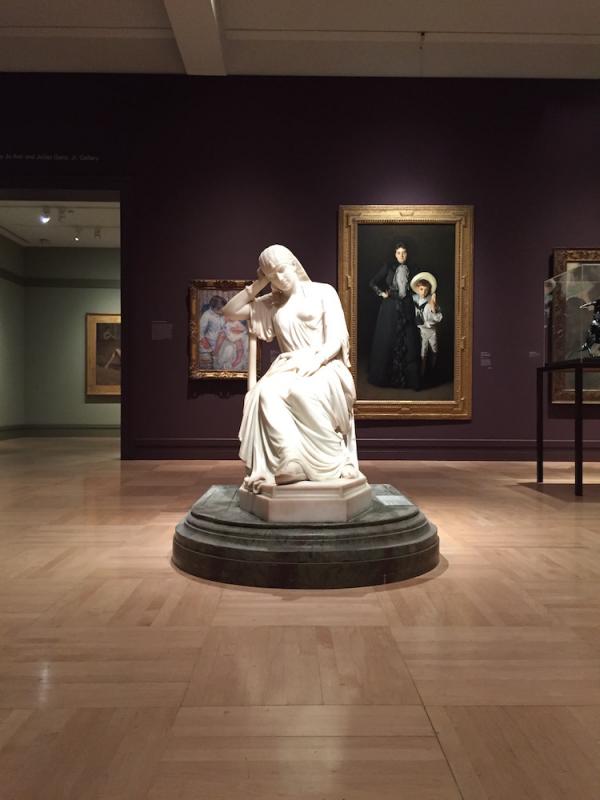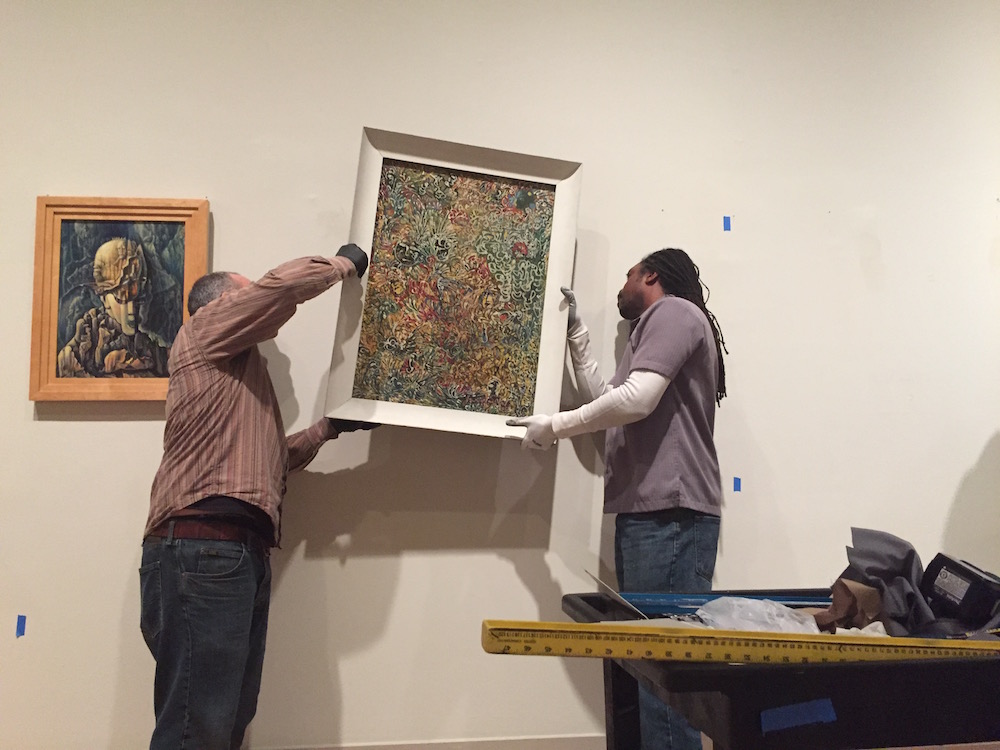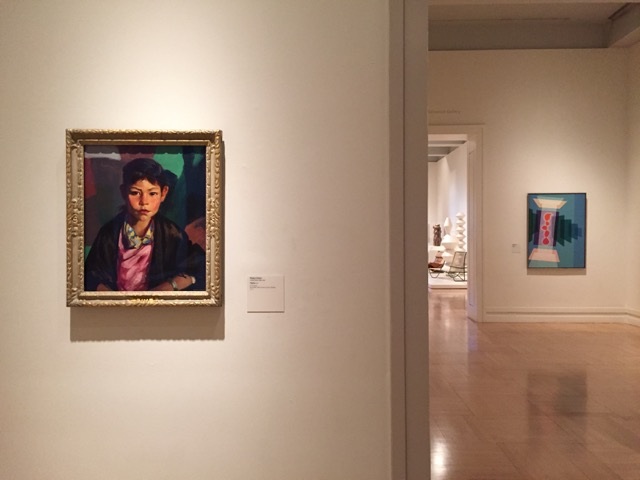The installers lay the bust slowly down on the foam pads that Ilene Susan Fort, Senior Curator and the Gail and John Liebes Curator of American Art, has recommended they use. The figure is wearing a shawl around the neck, and the garment makes the bust lie awkwardly, the foam nestling the head and shoulders.
"There," Ilene says. "She's more comfortable that way. I animate everything."
The Faces of America: LACMA Collects installation in the Art of the Americas building is coming down, making way for a room filled with 19th-century American Art—featuring pieces that haven't been on display for years.
The furniture is already deinstalled, placed on plywood risers, and tautly wrapped in heavy plastic, layered so thick it's almost opaque. Devi Noor, the curatorial assistant for American Art, steps between them, evaluating which pieces should be taken down next.
It's hard to hear Ilene over the drills and staple guns firing left and right, but she's spirited as she takes me through what remains of the installation. It’s a gallery of faces and figures from the American Art collection, of all ages, ethnicities, backgrounds, and styles. The walls of the Faces show were pleasantly crowded, eyes both familiar and unknown staring down at the patrons. She points out her favorites, tells me the stories of how people—especially children—responded to the show.
"Kids loved this show because they can see themselves in it. There was this little boy one of the docents was taking around who hadn't said a word. She didn't know if he was shy or what, but as soon as they walked into this room, he just started talking. Because he saw people who looked like him."
A bronze figure comes off of a high shelf, leaving behind a foot-long pole that had held the figure up. “I’ve started dreaming about installations again,” Ilene mutters, watching the proceedings. “That’s the worst—I’ve been dreaming about early 20th century paintings. You leave work, go to bed, and you’re dreaming about it.”
Ilene and Devi have worked together with the American art collection for the past decade. They are a tightly united front as the sculptures and paintings come down. In about a month, the gallery will be transformed and some of the pieces from the Faces show will be re-integrated into the permanent galleries.
But where to begin? When you’re starting with blank walls (no paint, even), how do you start to put an installation together?
“Well, first it’s the idea,” Devi says. As the idea begins to form, patterns emerge. What might have started as a chronological installation suddenly becomes thematic. Once the objects are chosen, a checklist is sent to Exhibitions, and exhibition designers begin to piece together the actual space.
“We’ll get back elevations of the paintings, how it looks like to the average-height person so you can see where the eye is. Some curators will hang high, some will hang low. Ilene tends to be a higher hanger. It’s all personal preference and it depends on the type of work, because you have to think about your public as well. If there are children, sometimes they like to touch, there are school groups, so you hang higher. It just depends.”
Once the plan is laid out, the nitty-gritty requires checks and balances—talking to security about fragile pieces, consulting with graphic designers and educators about labels, talking to the art prep and install team about installation. All of this is in addition to considering the physical space—where are the air vents? Where can the labels go? What is the lighting set-up in that gallery? What color will the walls be?
Fortunately, Devi and Ilene have been working with this room for years, so they know its particulars. Where it gets tricky is with installations in other buildings. “We had to install the Archibald Motley show in BCAM on the third floor," Devi says. "That was different because it has natural lighting. You also kind of have to make do with what you have, with what was there before. The show before Motley had a video room that had to be completely blacked out. So in that way, I could use prints and drawings and photographs [for an installation shown in conjunction with the Motley exhibition]. So you take your opportunities.”
Besides putting together exhibitions and installations, curators are often known as the “keepers” of the art.
“In a sense a curator is also an archivist,” Devi says. “We track and we also acquire for the future as well. To see what was done before us and what the curators will do in the future. So in that sense, do we want to fill in the holes? Do we want to fill in for the future and acquire for that? We want to preserve the work as much as possible for future generations, so that our children and their children can see this and the history of art. Of course we’re going to acquire and have a huge collection, but how much can we show? How much can we preserve? Where do we focus our efforts?”
The new pieces in the former Faces room are already mostly installed by the time I make my way to the gallery at the beginning of December. The walls of the room are a deep aubergine, with dimmed overhead lights. There’s a small platform against the wall, waiting for the table and lamp that will be displayed once an electrical cable is installed to power the lamp. With the colors of the walls and the new pieces, the room is decidedly warmer than it was for the previous show.
There are pallets laid down where the floor pieces will be—one bronze, one marble statue, and one case of silver. There’s also a temporary bench, where work papers are placed haphazardly.
A quick walk through the whole floor shows that many of the pieces from the Faces show have been rehung elsewhere in the gallery. There are holes in the wall from where previous pieces have been taken down, and hooks where they will go up next. Installers, equipped with levels and rulers and blue tape, mark the wall, and the paintings rest against the wall, propped up on foam pads.
In the back gallery, a spread of surrealist works are lined up against the wall. All because of one piece: Robert Henri’s Pepita (1917).
“It doesn’t really go with the surreal works,” Devi says, “but we wanted to keep it up and it actually works pretty well on that corner by itself. So we just had to shift everything over.” I ask her when that decision was made. She smiles. “Yesterday.”
They’re trying to decide where, horizontally, to hang the Henri. Where is the “middle” of the wall? Is it from the end or the opening of the door frame? Ilene takes a few paces back and looks at the Henri. “She’s crooked. Can you make her even?” The foam is exchanged and the frame is made level. “Perception is everything.” She’s satisfied that it’s centered and goes off to fix the measurements in the purple room.
As the measurements are made for the Henri, the labels are laid out. Daniel Wheeler, the installer, has them in a stack and looks up at the paintings. “Pop quiz,” Devi says. He gets them all right, laying them out underneath the paintings.
Ilene urges me to come with her to see what she’s doing.
“See,” she says, patting the doorway, “architects think in grids.” She points toward the pallet on the floor. “So I always line cases up with either the doorway, the molding, or the edge of a frame. It may look haphazard now, but it’s not. I always measure. In my galleries, we always measure.”
It’s these minute details that make the gallery experience seamless for the viewer. Ilene is actively thinking about the patron experience. What it will look like, feel like. She doesn’t want the cases interrupting the sightlines of the paintings. By the following week, Frederic Remington’s The Bronco Buster (modeled 1894–1895; cast c. 1907), William Wetmore Story’s Cleopatra (modeled 1858, carved 1860), and the silver pieces that populate the floor space are aligned perfectly, with Cleopatra’s head exactly between the Mary Cassatt and the John Singer Sargent.
American gallery panorama from LACMA on Vimeo.
The new gallery is now open on the third floor of the Art of the Americas building.





